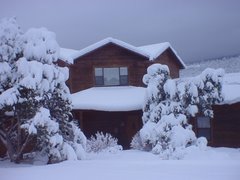Thursday I headed into the Park to take a tour (Susie doesn't do caves). Happened upon this little cemetery in the Park with an interesting name: Abandon hope all ye who enter here?
We started with the Cleaveland Avenue passageway, a mile or more of a broad canyon, sort of like a subway tunnel filled with a jumble of rocks. Lunch break was in an underground dining area called the Snowball Room because of these ceiling formations.
The path onward had a lot of ups and downs as the path passed over areas of fallen rock. We ended up in an area that included the "Frozen Niagra" formation. A lot of Mammoth Cave is covered by a impervious sandstone layer, so water has not seeped through it and formed the stalagtites and stalagmites you tend to associate with caves. The Frozen Niagra area, though, has these formations. Here are a couple of my pictures from here:
The story of how the National Park came into being is interesting, as Ranger Rick told us. In the 1930s different individuals owned separate parts of Mammoth Cave. Also, there are other caves in the region. Fierce competition broke out in what became known as the Kentucky Cave War. Confusing signs were posted: This way to official entrance to Mammoth Cave. This way to shortest route to MC. (The isgns are still there - confused us on our first drive to the Park. Now the signs are trying to get you to drive past various roadside attractions along the way.) Tourists would be intercepted by guys wearing ranger-like uniforms who would direct them to their employer's cave. Or, tell them that there was an outbreak of some disease like bat fever, so the cave you want to visit is quarantined. There was also vandalism against the competition's caves. The good people of KY decided to put a stop to this and to work to establish a National Park that would include all of Mammoth Cave. The US government couldn't buy up the land, so KY raised money by donations, during the Depression, to buy the land where they could, including the use of eminent domain to force some sales (Wikipedia says there is still lingering bad feelings about that) and put it all together. The National Park was dedicated in 1941. There is no fee to drive into the park. The tours are fee events.
I considered going back for a shorter tour on Friday, but my feet were still feeling the four-mile after-effects, so I drove the countryside looking for barn pictures. KY has a lot of barns like this, plain rectangles, unpainted, or black.
Here's a more traditional style:
Some farmland to admire:
In fact, there's a lot of farmland to admire. We've really been enjoying the pastures, fences, big farmhouses, etc. Next we're heading for Frankfort and the nearby Lexington horse country.
Until then,
Cheers,
Susie and Rob
















No comments:
Post a Comment